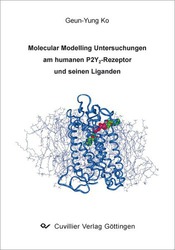| Departments | |
|---|---|
| Book Series (96) |
1378
|
| Nachhaltigkeit |
3
|
| Gesundheitswesen |
1
|
| Humanities |
2364
|
| Natural Sciences |
5406
|
| Mathematics | 229 |
| Informatics | 319 |
| Physics | 980 |
| Chemistry | 1363 |
| Geosciences | 131 |
| Human medicine | 243 |
| Stomatology | 10 |
| Veterinary medicine | 108 |
| Pharmacy | 147 |
| Biology | 835 |
| Biochemistry, molecular biology, gene technology | 121 |
| Biophysics | 25 |
| Domestic and nutritional science | 45 |
| Agricultural science | 1004 |
| Forest science | 201 |
| Horticultural science | 20 |
| Environmental research, ecology and landscape conservation | 148 |
| Engineering |
1792
|
| Common |
98
|
|
Leitlinien Unfallchirurgie
5. Auflage bestellen |
|
Advanced Search
Molecular Modelling Untersuchungen am humanen P2Y2-Rezeptor und seinen Liganden (English shop)
Geun-Yung Ko (Author)Preview
Table of Contents, Datei (26 KB)
Extract, Datei (110 KB)
The P2Y2-receptor is a G protein-coupled receptor. Due to its widely spread application for several diseases – e.g. neurodegenerative disease, osteoporosis, dry eye syndrome, cystic fibrosis, diabetes – it represents an interesting new drug target.
In the framework of this thesis molecular modelling techniques were employed, which enable a quantification of interactions, to elucidate the molecular relationships. Firstly, it was necessary for this purpose to generate a stereochemically allowed homology model. This model was validated for further investigations of protein-ligand interactions with the physiological agonists ATP and UTP. The validated protein structure provided a basis for molecular dynamics studies of ATP and UTP derivates, respectively.
On closer examination of the ATP complexed protein structure a ligand entrance channel to the binding site was found. This channel was directly used as a binding pocket by bigger ligands like AP4A.
In order to describe the behaviour of bigger antagonists in the protein closer, molecular dynamics simulations of these ligand-protein complexes were also carried out. The simulations resulted in three different types of antagonist binding modes. Furthermore, two energetically equivalent conformations of reactive blue 2 derivates were observed during the molecular dynamics simulations. The probability of these conformations was confirmed using quantum chemical ab initio calculations. These binding sites of antagonists were supported by the experimentally detected relevance of the amino acid Tyr114.
In addition, virtual structure variations were predicted which might present more potent antagonists of the P2Y2-receptor.
The shown P2Y2-receptor model offers feasible solutions for various problems and represents a rational basis for the development of more potent ligands.
Finally, several mutations – R272A, S296A, Y114A and Y118A – basing on this model support the conceptions regarding the structure of the ligand entrance channel as well as the agonist and antagonist binding site developed in this thesis.
| ISBN-13 (Printausgabe) | 3867275254 |
| ISBN-13 (Hard Copy) | 9783867275255 |
| ISBN-13 (eBook) | 9783736925250 |
| Language | English |
| Page Number | 184 |
| Edition | 1 |
| Volume | 0 |
| Publication Place | Göttingen |
| Place of Dissertation | Düsseldorf |
| Publication Date | 2008-02-20 |
| General Categorization | Dissertation |
| Departments |
Pharmacy
|








